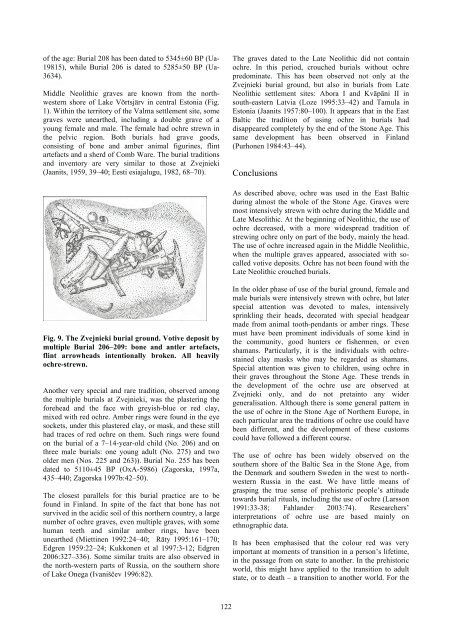The Materiality of Death - mikroarkeologi.se
The Materiality of Death - mikroarkeologi.se
The Materiality of Death - mikroarkeologi.se
You also want an ePaper? Increase the reach of your titles
YUMPU automatically turns print PDFs into web optimized ePapers that Google loves.
<strong>of</strong> the age: Burial 208 has been dated to 5345±60 BP (Ua-<br />
19815), while Burial 206 is dated to 5285±50 BP (Ua-<br />
3634).<br />
Middle Neolithic graves are known from the northwestern<br />
shore <strong>of</strong> Lake Võrtsjärv in central Estonia (Fig.<br />
1). Within the territory <strong>of</strong> the Valma <strong>se</strong>ttlement site, some<br />
graves were unearthed, including a double grave <strong>of</strong> a<br />
young female and male. <strong>The</strong> female had ochre strewn in<br />
the pelvic region. Both burials had grave goods,<br />
consisting <strong>of</strong> bone and amber animal figurines, flint<br />
artefacts and a sherd <strong>of</strong> Comb Ware. <strong>The</strong> burial traditions<br />
and inventory are very similar to tho<strong>se</strong> at Zvejnieki<br />
(Jaanits, 1959, 39–40; Eesti esiajalugu, 1982, 68–70).<br />
<strong>The</strong> graves dated to the Late Neolithic did not contain<br />
ochre. In this period, crouched burials without ochre<br />
predominate. This has been ob<strong>se</strong>rved not only at the<br />
Zvejnieki burial ground, but also in burials from Late<br />
Neolithic <strong>se</strong>ttlement sites: Abora I and Kvpni II in<br />
south-eastern Latvia (Loze 1995:33–42) and Tamula in<br />
Estonia (Jaanits 1957:80–100). It appears that in the East<br />
Baltic the tradition <strong>of</strong> using ochre in burials had<br />
disappeared completely by the end <strong>of</strong> the Stone Age. This<br />
same development has been ob<strong>se</strong>rved in Finland<br />
(Purhonen 1984:43–44).<br />
Conclusions<br />
As described above, ochre was u<strong>se</strong>d in the East Baltic<br />
during almost the whole <strong>of</strong> the Stone Age. Graves were<br />
most intensively strewn with ochre during the Middle and<br />
Late Mesolithic. At the beginning <strong>of</strong> Neolithic, the u<strong>se</strong> <strong>of</strong><br />
ochre decrea<strong>se</strong>d, with a more widespread tradition <strong>of</strong><br />
strewing ochre only on part <strong>of</strong> the body, mainly the head.<br />
<strong>The</strong> u<strong>se</strong> <strong>of</strong> ochre increa<strong>se</strong>d again in the Middle Neolithic,<br />
when the multiple graves appeared, associated with socalled<br />
votive deposits. Ochre has not been found with the<br />
Late Neolithic crouched burials.<br />
Fig. 9. <strong>The</strong> Zvejnieki burial ground. Votive deposit by<br />
multiple Burial 206–209: bone and antler artefacts,<br />
flint arrowheads intentionally broken. All heavily<br />
ochre-strewn.<br />
Another very special and rare tradition, ob<strong>se</strong>rved among<br />
the multiple burials at Zvejnieki, was the plastering the<br />
forehead and the face with greyish-blue or red clay,<br />
mixed with red ochre. Amber rings were found in the eye<br />
sockets, under this plastered clay, or mask, and the<strong>se</strong> still<br />
had traces <strong>of</strong> red ochre on them. Such rings were found<br />
on the burial <strong>of</strong> a 7–14-year-old child (No. 206) and on<br />
three male burials: one young adult (No. 275) and two<br />
older men (Nos. 225 and 263)). Burial No. 255 has been<br />
dated to 5110±45 BP (OxA-5986) (Zagorska, 1997a,<br />
435–440; Zagorska 1997b:42–50).<br />
<strong>The</strong> clo<strong>se</strong>st parallels for this burial practice are to be<br />
found in Finland. In spite <strong>of</strong> the fact that bone has not<br />
survived in the acidic soil <strong>of</strong> this northern country, a large<br />
number <strong>of</strong> ochre graves, even multiple graves, with some<br />
human teeth and similar amber rings, have been<br />
unearthed (Miettinen 1992:24–40; Räty 1995:161–170;<br />
Edgren 1959:22–24; Kukkonen et al 1997:3-12; Edgren<br />
2006:327–336). Some similar traits are also ob<strong>se</strong>rved in<br />
the north-western parts <strong>of</strong> Russia, on the southern shore<br />
<strong>of</strong> Lake Onega (Ivaniev 1996:82).<br />
In the older pha<strong>se</strong> <strong>of</strong> u<strong>se</strong> <strong>of</strong> the burial ground, female and<br />
male burials were intensively strewn with ochre, but later<br />
special attention was devoted to males, intensively<br />
sprinkling their heads, decorated with special headgear<br />
made from animal tooth-pendants or amber rings. <strong>The</strong><strong>se</strong><br />
must have been prominent individuals <strong>of</strong> some kind in<br />
the community, good hunters or fishermen, or even<br />
shamans. Particularly, it is the individuals with ochrestained<br />
clay masks who may be regarded as shamans.<br />
Special attention was given to children, using ochre in<br />
their graves throughout the Stone Age. <strong>The</strong><strong>se</strong> trends in<br />
the development <strong>of</strong> the ochre u<strong>se</strong> are ob<strong>se</strong>rved at<br />
Zvejnieki only, and do not pretainto any wider<br />
generalisation. Although there is some general pattern in<br />
the u<strong>se</strong> <strong>of</strong> ochre in the Stone Age <strong>of</strong> Northern Europe, in<br />
each particular area the traditions <strong>of</strong> ochre u<strong>se</strong> could have<br />
been different, and the development <strong>of</strong> the<strong>se</strong> customs<br />
could have followed a different cour<strong>se</strong>.<br />
<strong>The</strong> u<strong>se</strong> <strong>of</strong> ochre has been widely ob<strong>se</strong>rved on the<br />
southern shore <strong>of</strong> the Baltic Sea in the Stone Age, from<br />
the Denmark and southern Sweden in the west to northwestern<br />
Russia in the east. We have little means <strong>of</strong><br />
grasping the true <strong>se</strong>n<strong>se</strong> <strong>of</strong> prehistoric people’s attitude<br />
towards burial rituals, including the u<strong>se</strong> <strong>of</strong> ochre (Larsson<br />
1991:33-38; Fahlander 2003:74). Re<strong>se</strong>archers’<br />
interpretations <strong>of</strong> ochre u<strong>se</strong> are ba<strong>se</strong>d mainly on<br />
ethnographic data.<br />
It has been emphasi<strong>se</strong>d that the colour red was very<br />
important at moments <strong>of</strong> transition in a person’s lifetime,<br />
in the passage from on state to another. In the prehistoric<br />
world, this might have applied to the transition to adult<br />
state, or to death – a transition to another world. For the<br />
122
















